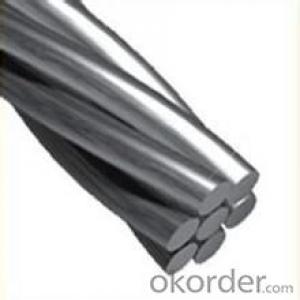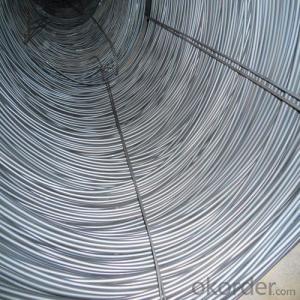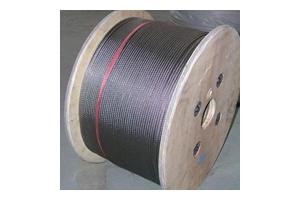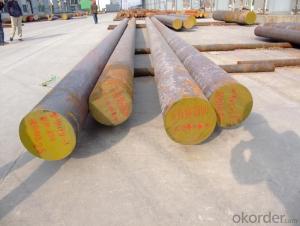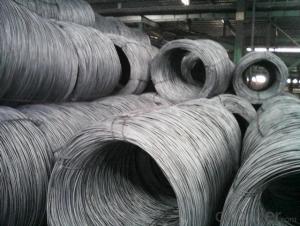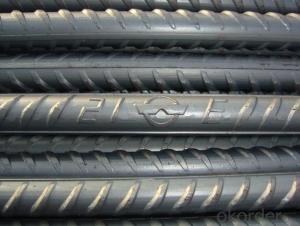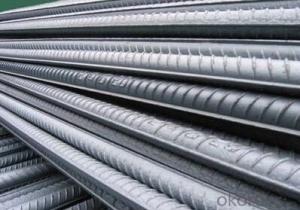Steel Rebar with Hight Quality for Construction
- Loading Port:
- China main port
- Payment Terms:
- TT or LC
- Min Order Qty:
- 25000 m.t.
- Supply Capability:
- 100000 m.t./month
OKorder Service Pledge
OKorder Financial Service
You Might Also Like
Product Description:
Specifications of Steel Rebar with Hight Quality for Construction:
Standard | GB UK USA | HRB335 HRB400 HRB500 G460B, B500A, B500B,B500C GR40, GR60 | |
Diameter | 6mm,8mm,10mm,12mm,14mm,16mm,18mm,20mm, 22mm,25mm,28mm,32mm,36mm,40mm,50mm | ||
Length | 6M, 9M,12M or as required | ||
Price | Keep lower operating costs so as to offer competitive price for our clients | ||
Delivery Detail | within 45 days after received advanced payment or LC. | ||
Application | mainly used in construction industry to reinforce concrete structures and so on | ||
Invoicing | Actual or Theoretical Weight Basis as buyer’s request. | ||
Type | Hot rolled steel rebar | ||
Brand name | DRAGON | ||
Theoretical weight and section area of each diameter as below for your information:
Diameter(mm) | Section area (mm²) | Mass(kg/m) | Weight of 12m (kg) | Pcs/ton |
6 | 28.27 | 0.222 | 2.664 | 375.38 |
8 | 50.27 | 0.395 | 4.74 | 210.97 |
10 | 78.54 | 0.617 | 7.404 | 135.06 |
12 | 113.1 | 0.888 | 10.656 | 93.84 |
14 | 153.9 | 1.21 | 14.52 | 68.87 |
16 | 201.1 | 1.58 | 18.96 | 52.74 |
18 | 254.5 | 2.00 | 24 | 41.67 |
20 | 314.2 | 2.47 | 29.64 | 33.74 |
22 | 380.1 | 2.98 | 35.76 | 27.96 |
25 | 490.9 | 3.85 | 46.2 | 21.65 |
28 | 615.8 | 4.83 | 57.96 | 17.25 |
32 | 804.2 | 6.31 | 75.72 | 13.21 |
36 | 1018 | 7.99 | 98.88 | 10.43 |
40 | 1257 | 9.87 | 118.44 | 8.44 |
50 | 1964 | 15.42 | 185.04 | 5.40 |
The production process of Steel Rebar with Hight Quality for Construction:

1-Waling beam furnace 2-Roughing rolling group 3-Intermediate rolling train
4-Finishing rolling group 5-Water-cooling device 6-Walking beam cooler
7-Finishing equipment(including the cold scale shear,short feet collection system,
automatic counting device,bundling machine, collect bench)
Usage and Applications of Steel Rebar with Hight Quality for Construction:
Deformed bar is widely used in buildings, bridges, roads and other engineering construction. Big to highways, railways, bridges, culverts, tunnels, public facilities such as flood control, dam, small to housing construction, beam, column, wall and the foundation of the plate, deformed bar is an integral structure material. With the development of world economy and the vigorous development of infrastructure construction, real estate, the demand for deformed bar will be larger and larger..
Packaging & Delivery of Steel Rebar with Hight Quality for Construction:
Packaging Detail: products are packed in bundle and then shipped by container or bulk vessel, deformed bar is usually naked strapping delivery, when storing, please pay attention to moisture proof. The performance of rust will produce adverse effect.
Each bundle weight: 2-3MT, or as required
Payment terms: TT payment in advance or Irrevocable LC at sight.
Trade terms :FOB, CFR, CIF
Label:to be specified by customer, generally, each bundle has 1-2 labels
Steel Rebar in stock
FAQ:
Q1: Why buy Materials & Equipment from OKorder.com?
A1: All products offered byOKorder.com are carefully selected from China's most reliable manufacturing enterprises. Through its ISO certifications, OKorder.com adheres to the highest standards and a commitment to supply chain safety and customer satisfaction.
Q2: What makes stainless steel stainless?
A: Stainless steel must contain at least 10.5 % chromium. It is this element that reacts with the oxygen in the air to form a complex chrome-oxide surface layer that is invisible but strong enough to prevent further oxygen from "staining" (rusting) the surface. Higher levels of chromium and the addition of other alloying elements such as nickel and molybdenum enhance this surface layer and improve the corrosion resistance of the stainless material.
Q3: Can stainless steel rust?
A3: Stainless does not "rust" as you think of regular steel rusting with a red oxide on the surface that flakes off. If you see red rust it is probably due to some iron particles that have contaminated the surface of the stainless steel and it is these iron particles that are rusting. Look at the source of the rusting and see if you can remove it from the surface.
Images
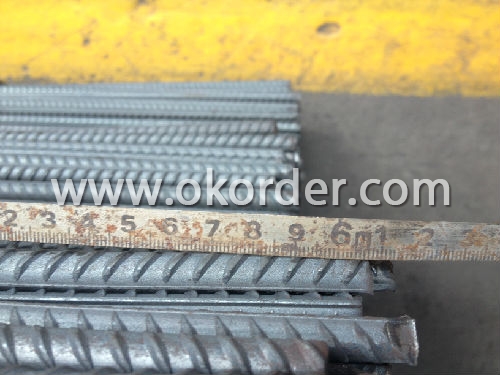
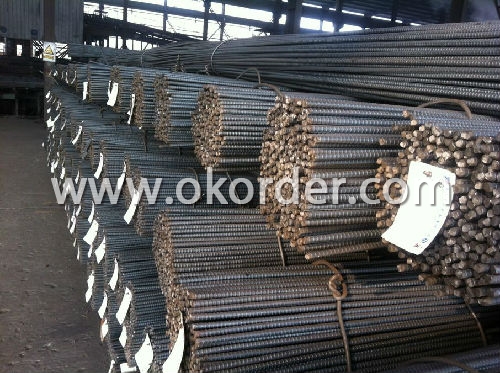
- Q: How does the tensile strength of steel wire rod vary with different diameters?
- The tensile strength of steel wire rod generally increases with larger diameters. This is because the larger diameter allows for more material, resulting in a higher capacity to withstand tension before breaking. However, it is important to note that other factors such as the specific alloy composition, manufacturing process, and heat treatment can also affect the tensile strength of steel wire rods.
- Q: How is steel wire rod used in the manufacturing of wire for hairpins?
- Steel wire rod is used in the manufacturing of wire for hairpins by being drawn through a series of dies to reduce its diameter and increase its length. This process, known as wire drawing, allows the steel wire rod to be transformed into a thin and flexible wire, which is then further processed to create hairpin wires.
- Q: What are the advantages of using steel wire rod in architectural applications?
- There are several advantages of using steel wire rod in architectural applications. Firstly, steel wire rod is known for its high strength and durability, making it an ideal choice for structural purposes. It can withstand heavy loads and resist deformation, ensuring the stability and longevity of architectural structures. Secondly, steel wire rod has excellent flexibility, allowing it to be easily shaped and manipulated into various architectural designs. This versatility enables architects to create intricate and complex structures, such as curvilinear shapes or intricate facades. Additionally, steel wire rod is corrosion-resistant, which is crucial for outdoor architectural applications. It can withstand exposure to harsh weather conditions, preventing rust and deterioration over time. This extends the lifespan of the architectural structure and reduces maintenance costs. Moreover, steel wire rod is a sustainable choice for architects as it is recyclable. It can be melted down and reused, reducing the demand for new materials and minimizing environmental impact. Overall, the advantages of using steel wire rod in architectural applications include its strength, flexibility, corrosion resistance, and eco-friendliness, making it a popular choice for architects looking for a reliable and sustainable material.
- Q: How does the brittleness of steel wire rod vary with different wire drawing processes?
- Different wire drawing processes can result in varying brittleness of steel wire rod. Wire drawing involves reducing the wire's diameter by pulling it through dies. The specific process used has a significant impact on the wire's final properties, including brittleness. One factor affecting brittleness is the reduction in area during wire drawing. This refers to the amount of material removed as the wire passes through the dies. Higher reductions in area lead to more deformation and strain, increasing brittleness. This occurs because the steel's grain structure becomes elongated and aligned, making it more prone to cracking and breaking under stress. Another influence on brittleness is the drawing speed. Higher speeds create greater strain and deformation, increasing brittleness. Rapid cooling during drawing can also contribute to brittleness by promoting the formation of brittle phases in the steel structure. The heat treatment applied after drawing can also impact brittleness. Processes like annealing can relieve internal stresses and improve wire ductility, reducing brittleness. Conversely, improper heat treatment or inadequate cooling can increase brittleness. To achieve desired mechanical properties, manufacturers must carefully control factors such as reduction in area, drawing speed, cooling rate, and heat treatment. By doing so, they can ensure the desired brittleness of the steel wire rod.
- Q: What are the main factors affecting the product reliability of steel wire rod?
- The main factors affecting the product reliability of steel wire rod include the quality of the raw materials used, the manufacturing process, the maintenance and handling practices during production, and the environmental conditions in which the wire rod is used. Other factors such as equipment performance, operator skills, and quality control measures also play a significant role in determining the reliability of the final product.
- Q: What are the chemical composition requirements for steel wire rod?
- The chemical composition requirements for steel wire rod generally include specific percentages of carbon, manganese, silicon, sulfur, and phosphorus. These requirements vary depending on the specific grade and intended use of the wire rod.
- Q: What are the different types of wire drawing dies used for steel wire rod?
- There are several types of wire drawing dies that are commonly used for steel wire rod. These include: 1. Single crystal natural diamond dies: These dies are made from a single crystal diamond and are known for their high hardness and wear resistance. They can be used for drawing high carbon steel wire rod as well as stainless steel wire rod. 2. Polycrystalline diamond (PCD) dies: PCD dies are made from multiple small diamond crystals that are bonded together. They offer good wear resistance and can be used for drawing steel wire rod with intermediate carbon content. 3. Tungsten carbide dies: Tungsten carbide is a hard and durable material that is often used for wire drawing dies. These dies can handle high carbon steel wire rod and are known for their ability to withstand high pressures and temperatures. 4. Natural diamond dies with carbide support: These dies have a natural diamond core with a carbide support structure. The diamond provides excellent wear resistance while the carbide support adds strength and stability. They are suitable for drawing steel wire rod with high carbon content. 5. PCD dies with carbide support: Similar to the above, these dies have a PCD core with a carbide support structure. They offer good wear resistance and can handle steel wire rod with intermediate carbon content. 6. Polycrystalline diamond composite (PDC) dies: PDC dies are made by sintering diamond particles with a binder material. They are known for their high wear resistance and are often used for drawing steel wire rod with low to medium carbon content. Each type of wire drawing die has its own advantages and is suitable for specific applications based on the carbon content and other properties of the steel wire rod being drawn.
- Q: What are the main properties of steel wire rod?
- The main properties of steel wire rod include high tensile strength, excellent ductility, good corrosion resistance, and high thermal conductivity. It is also known for its versatility and ability to be easily formed and shaped into various products. Additionally, steel wire rod has a high melting point and is highly resistant to wear and tear, making it ideal for applications that require durability and strength.
- Q: How is the machinability of steel wire rod determined?
- The machinability of steel wire rod is determined by various factors such as its chemical composition, microstructure, hardness, and surface finish. These characteristics affect the ease with which the wire rod can be cut, drilled, or machined. Additionally, factors like the cutting tool material and geometry, cutting speed, and feed rate also play a role in determining the machinability of steel wire rod. By considering these factors, manufacturers can evaluate and optimize the machinability of steel wire rod for specific applications.
- Q: What is the typical diameter range of steel wire rod?
- The typical diameter range of steel wire rod can vary depending on the specific application and industry. However, in general, steel wire rods typically have a diameter ranging from 5.5mm to 20mm. The specific diameter chosen for a particular wire rod is determined by factors such as the intended use, strength requirements, and manufacturing processes. Different industries, such as construction, automotive, and electrical, may have their own specific diameter requirements for steel wire rods to meet the desired properties and performance standards of their products.
Send your message to us
Steel Rebar with Hight Quality for Construction
- Loading Port:
- China main port
- Payment Terms:
- TT or LC
- Min Order Qty:
- 25000 m.t.
- Supply Capability:
- 100000 m.t./month
OKorder Service Pledge
OKorder Financial Service
Similar products
Hot products
Hot Searches
Related keywords









